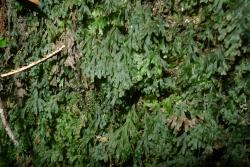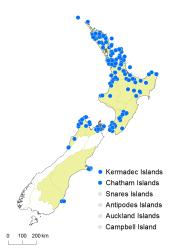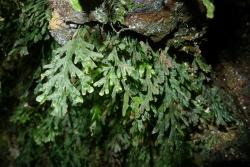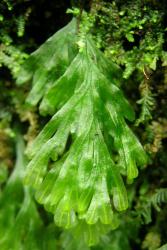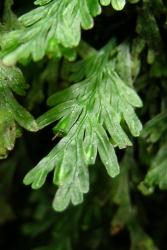- ≡ Crepidopteris endlicheriana (C.Presl) Copel., Philipp. J. Sci. 67: 58 (1938)
- ≡ Crepidophyllum endlicherianum (C.Presl) C.F.Reed, Amer. Fern J. 38: 89 (1948)
- ≡ Reediella endlicheriana (C.Presl) Pic.Serm., Webbia 24: 719 (1970)
- ≡ Crepidomanes endlicherianum (C.Presl) P.S.Green, Kew Bull. 48: 618 (1993)
- ≡ Polyphlebium endlicherianum (C.Presl) Ebihara & K.Iwats. in Ebihara et al., Blumea 51: 240 (2006)
- = Trichomanes aureum Bosch, Ned. Kruidk. Arch. 5(3): 208 (1863)
Usually terrestrial or rupestral ferns, occasionally at the base of trunks. Rhizomes long-creeping, filiform, c. 0.2 mm diameter, bearing dense brown hairs up to 0.5 mm long. Fronds 22–130 mm long. Stipes 2–30 mm long, brown proximally becoming green distally, winged for at least half their length, glabrous or with a few short scattered clavate hairs. Laminae 2-pinnatifid or rarely 1-pinnatifid, rather irregular in outline (narrowly elliptic or elliptic or narrowly obovate or obovate), 17–110 mm long, 5–27 mm wide, dark green, membranous, glabrous or bearing short scattered clavate hairs along the veins. Rachises winged throughout, dark green, glabrous or bearing short scattered clavate hairs. Primary pinnae in 3–10 pairs, not overlapping, linear or narrowly elliptic or elliptic or obovate, adnate or decurrent; the longest primary pinnae at or above or below the middle, 5–38 mm long, 1.5–12 mm wide. Ultimate segments linear or oblong, up to 10 mm long, 0.8–1.5 mm wide, with a single unbranched vein in each; apices obtuse, often emarginate; margins entire with a clearly defined unistratose border of elongated cells with oblique end-walls. Sori borne on short acroscopic segments near bases of primary pinnae, 1 on each primary pinna, immersed in lamina with a wing 3 or more cells wide at mid-length; indusia tubular, 1.5–2.5 mm long, widened at mouth; sporangia borne on a fine receptacle up to 20 mm long, projecting well beyond the indusia at maturity.
Trichomanes endlicherianum is similar in appearance and habitat to T. colensoi. It is distinguished by its less divided frond, winged stipe and rachis, adnate pinnae, lamina segments with a distinct border, and indusia immersed in the lamina. It is distinguished from T. venosum by its terrestrial habitat, dark green frond and ultimate segments with a single unbranched vein. It is superficially very similar to T. humile but can be distinguished by the presence of roots, the unistratose rather than bistratose border, and by the wing of laminal cells either side of the sori which are 3 or more cells wide at mid-length, rather than only 1–2 cells wide.
North Island: Northland, Auckland, Volcanic Plateau, Gisborne, Taranaki, Southern North Island.
South Island: Western Nelson, Sounds Nelson, Canterbury, Otago.
Kermadec Islands, Three Kings Islands, Chatham Islands.
Altitudinal range: 0–830 m.
In the North Island Trichomanes endlicherianum is widespread from Kaitaia south to Mt Taranaki and the Hawke’s Bay ranges. It is absent from much of the central North Island, but occurs from the Tararua Ranges south to Wellington city. It occurs in lowland to montane forest, extending from near sea level to 600 m in Waimā Forest, Northland, and 830 m on Mt Pirongia. In the South Island T. endlicherianum is confined to coastal and lowland forest from the Marlborough Sounds and north-west Nelson, south to Greymouth on the west coast, with outlying populations on Banks Peninsula and around Dunedin on the east coast. It reaches 260 m near Karamea. There is a single collection from the Chatham Islands (AK 228204).
Also Borneo (Mt Kinabalu), Papua New Guinea, Australia (Queensland), Norfolk Island, Vanuatu, Fiji, Samoa, Society Islands, Marquesas Islands, Austral Islands, Pitcairn Island.
Occurs on damp rock, under overhangs, at the base of Rhopalostylis sapida trunks or occasionally on Dicksonia squarrosa, on the underside of fallen trunks, or beside streams in dark, wet, broadleaved forest, or rarely in beech forest. It often grows with Trichomanes colensoi and Loxogramme dictyopteris.
In the classification of Ebihara et al. (2006), Trichomanes endlicherianum is treated as Polyphlebium endlicherianum.
The name Trichomanes humile Forst.f., and combinations based on it, have been widely misapplied to this species in New Zealand, but both species are now known to occur on the Kermadec Islands.
Copeland (1933), Allan (1961) and Brownlie (1977) included T. alternans Carruth. (type from Fiji), T. tenue Brack. (type from Tahiti) and T. erectum Brack. (type from Fiji) in synonymy with T. endlicherianum. However, some plants from Fiji and French Polynesia are very different genetically to New Zealand plants (Perrie et al. 2016). Plants from Fiji and Samoa are also morphologically different, having much narrower lamina segments, and indusia that are not immersed in the lamina, but plants from Tahiti are rather similar to those of New Zealand, Norfolk Island and Australia. The relationship of plants in New Zealand to those in the Pacific requires further investigation.



